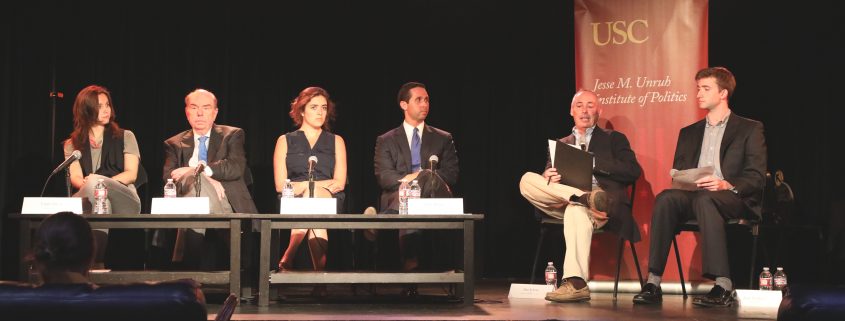Panel speaks about social media in election
Panelists discussed how traditional media and social media drive the 2016 presidential election Tuesday in the third installment of the Road to the White House series, “Media and Politics: Traditional, New Media and Social Media,” Tuesday at the Ground Zero Performance Cafe.
The event included a panel featuring John Thomas, CEO and president of Thomas Partners Strategies; Bob Shrum, Carmen H. and Louis Warschaw Chair in Practical Politics at USC Dornsife; Laura Davis, digital news director of the Annenberg Center; and Alison Main, a student producer for Annenberg TV News, discussed how the 2016 presidential election is portrayed in the media. Dan Schnur, the director of USC Jesse M. Unruh Institute of Politics, and Jack Walker, associate managing editor of the Daily Trojan, moderated the event.
The panelists all stressed the importance of traditional media in campaigns, as it is where people still get a majority of their information, despite the large reliance on social media by presidential candidates Donald Trump and Hillary Clinton.
“Traditional media is still critical,” Shrum said. “We are fascinated with social media, but it’s a tool, it’s not a message. You have to have a framework or a message.”
Thomas expressed his concern for people becoming screen agnostic. People watch television on their phones and computers, requiring politicians to follow their lead. To counter this issue, politicians will use social media to kickstart their broadcast campaigns. Social media is a conversation starter.
Davis brought up how this is shown through Donald Trump’s use of Twitter. He will tweet something controversial early in the morning before an interview so there will be something to talk about in the broadcast. This strategy helped him get to where he is because it reaches the public more than traditional advertising.
“Three years ago, five to seven percent of our persuasion budget was on online activities,” Thomas said. “Now we are at 15 to 20 percent, and every cycle it seems to inch up by 2-7 percent.”
However, social media isn’t always reliable, Thomas said, adding that though social media is heavily used for advertising a campaign, it is still filled with clutter. The panel mutually agreed that though there is an advantage to the use of social media, it is still filled with false advertising and sensationalized articles.
Davis said that as the digital news director of the Annenberg Media Center, she understood the dangers of social media and warned of what she called the “filter bubble.” In the “filter bubble,” Davis said, social media allows one to create their own world and reality, and in this world there are fake news sites and propaganda trying to take advantage of individuals’ bubble. Davis said that this can hinder one’s ideas and stances on issues.
“Fake news organizations are growing on Facebook, and this content is getting spread,” Davis said. “I think it’s having an actual effect on democracy, because people are not believing sources like they might have in the past. I think the filter bubble, the algorithms that the social networks use to show you content that they think you want is having a real impact on democracy and possibly on this election.”
Though social media has a large influence on campaigns, Thomas still stressed the need for stories to be told in politics, as nothing can be told without a story. Shrum added that a message must be framed, because social media comes and goes as trends do, but stories will always stay and maintain their importance in politics.
“Campaigns still need certain basic things,” Shrum said. “They need a message and framing. They need discipline. They need polling and survey research and focus groups. If they don’t have them, or they don’t choose to use them, then this [social media] can become a lethal weapon that you turn on yourself.”

